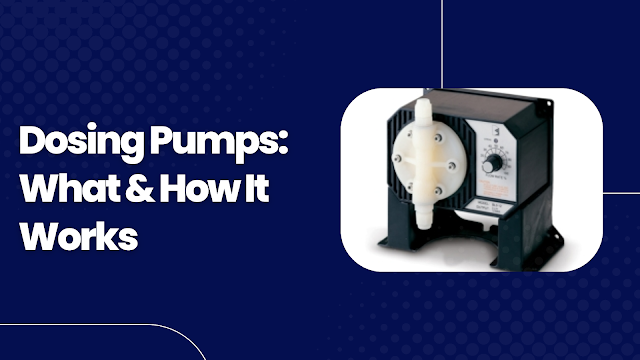What are Dosing Pumps and How It Works?
Positive displacement pumps are dosing pumps that inject chemicals or other materials into the flow of water, gas, or steam. Small dosing pumps offer an exact flow rate for optimal control. They are the focal point of an integrated dosing system created for the chemical industry's autonomous chemical dispersion. The applications and industries covered by this definition of dosage span from food processing to wastewater treatment.
How Does a Dosing Pump Work?
A dosing pump sucks a specific volume of fluid into its chamber, injects the chemical into a tank or pipe containing the liquid to be dosed, and then repeats the process. It is driven by an electric motor or an air actuator, and it features a controller that handles the flow rate and spins the pump on and off. More advanced control mechanisms are featured in some versions.
Parts of a Chemical Dosing System
A chemical dosing system consists of these parts:
- Chemical Container
- Injector
- Pump
- Dosing Line
- Control System
- Foot Valve
Types of Dosing Pumps
These four dosing pump types were created to serve various purposes, pressures, and chemicals. By way of pumping, action, and mechanism, they differ.
Diaphragm (constant injection) Pumps
Pumps with a diaphragm (constant injection) use a piston, an inlet, and an outlet valve to fill and empty their chamber. A certain quantity of chemical is injected at a predetermined speed, typically a percentage of the maximum flow rate, once the room is filled by drawing in the piston. Variable dosage rates are possible with some pump models.
Diaphragm (pulse injection) Pumps
The diaphragm mechanism is also used in diaphragm (pulse injection) pumps; however, instead of a constant flow rate, the chemical is taken in and injected in pulses by a solenoid coil. The interval between pulses is the flow rate. Although it has a more straightforward construction and costs less than the constant injection pump, it is less precise.
Lobe Pumps
A specific fluid is passed through meshing gear impellors using lobe pumps. It is only appropriate for high viscosity fluids that will self-lubricate to reduce wear, and it is not as specific as a diaphragm pump. Low flow rates are not suitable for them since it is challenging to ensure precision.
Peristaltic Pumps
Dosing with peristaltic pumps is quite precise. The fluid is allowed to pass via a flexible, bent tube, and the flow is managed by a roller that moves via an external mechanical arm. The product in the tube is pushed into the dosing tube and the primary fluid stream.
Applications of Dosing Pumps
Dosing pumps are employed in several commercial, municipal, industrial, and maritime applications. The following industries employ them for water treatment applications:
- Agriculture
- Cow farms
- Horticulture
- Breweries
- Power production
- Gas and oil
After learning how dosing pumps function and how important they are, you may have understood how crucial it is to purchase from a reputable provider.
Jade Scientific Inc is one of the market's top suppliers of dosing pumps and other laboratory equipment.




Comments
Post a Comment